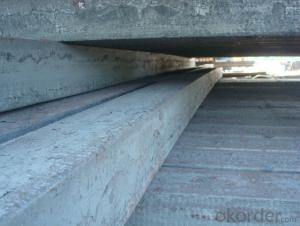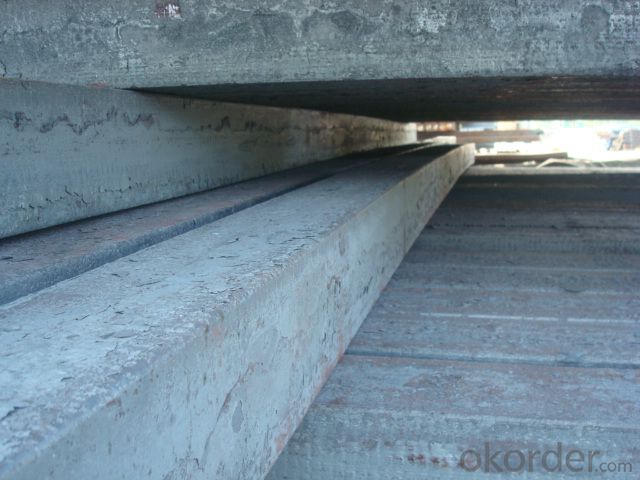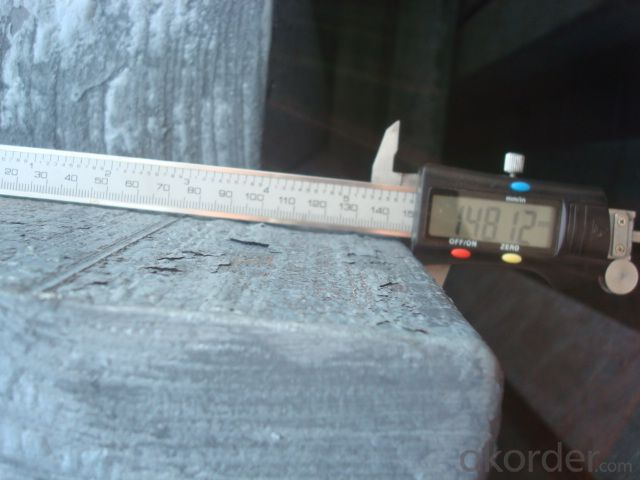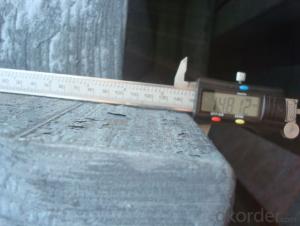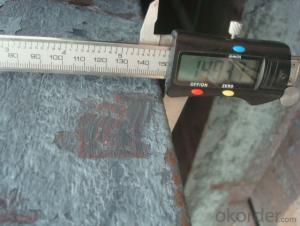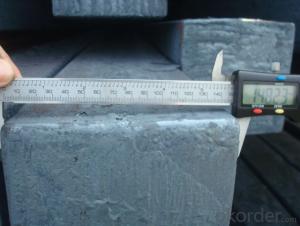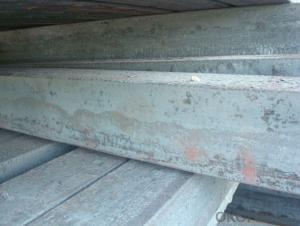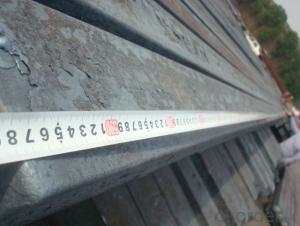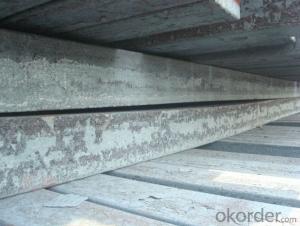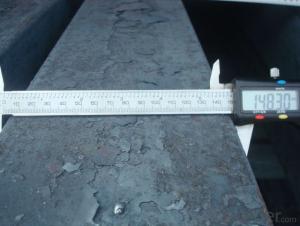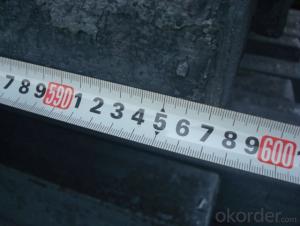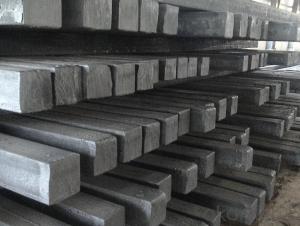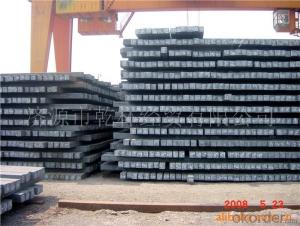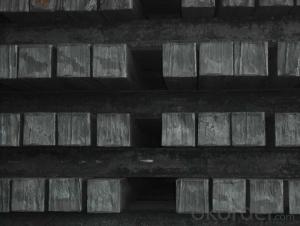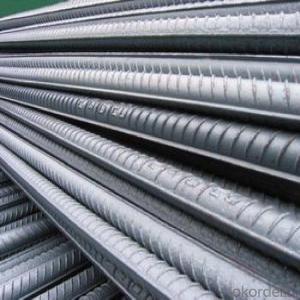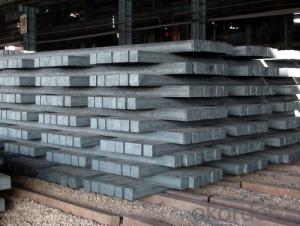Continue Casting Steel Bloom by Blast Furnace
- Loading Port:
- Tianjin
- Payment Terms:
- TT OR LC
- Min Order Qty:
- 2000 m.t.
- Supply Capability:
- 100000 m.t./month
OKorder Service Pledge
OKorder Financial Service
You Might Also Like
Continue Casting Steel Bloom by Blast Furnace
1.Structure of Continue Casting Steel Bloom by Blast Furnace
Continue Casting Steel Bloom by Blast Furnace is the raw material of all kinds of steel mill. Billet section of square, round, flat, rectangular and abnormity, etc Several, mainly related to shape of rolled products. Simple rolled section steel, choose cross section of square billet or rectangular billet. rolling The sector products such as flat steel, Angle steel, select the rectangular billet or slab. Had better profiled billet when production beams, channels, and in rolling process Lines and improve the yield. The raw material of round billet is the production of seamless tube.
2.Main Features of Continue Casting Steel Bloom by Blast Furnace.
Continue Casting Steel Bloom by Blast Furnace section size should meet the requirements of rolling deformation and finished product quality, but also roll strength and biting condition of restrictions. General steel Billet section height H. And the roll diameter D The ratio of the ( namely H/D) Should be less than or equal to zero 0.5 . Length of steel billet by finishing temperature, Rolling time and the length of the product Or times ruler. When heated too long accident prone to bump the furnace wall of steel, too short, furnace bottom utilization rate is not high, influence the heating furnace production. For the production Choose a variety of steel and steel billet, should consider the affinities of billet, as far as possible in order to improve the productivity of the roughing mill, simplify the stock management of workshop.
3. Continue Casting Steel Bloom by Blast Furnace Images
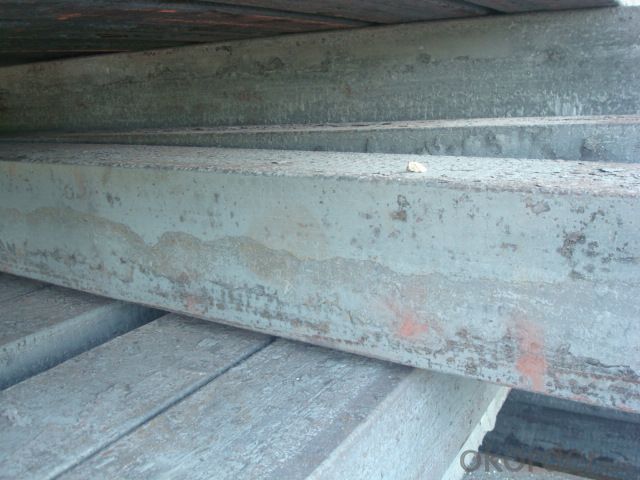
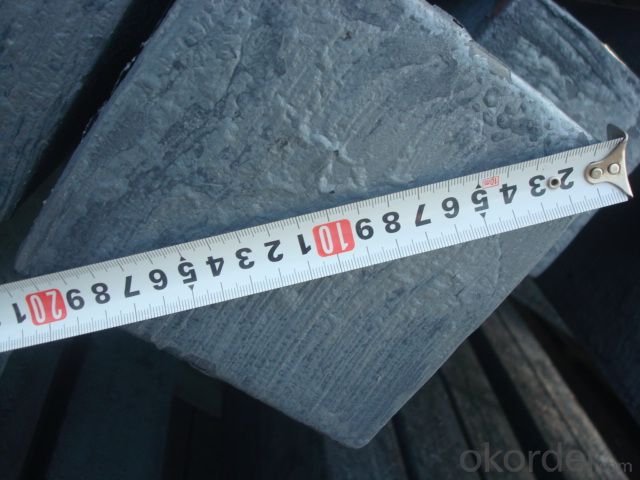
4. Continue Casting Steel Bloom by Blast Furnace Specification
Continue Casting Steel Bloom by Blast Furnace rolled steel, after processing can be used for mechanical parts, forging parts, processing all kinds of steel, steel Q345B channel steel, wire rod is the role of the billet. Steel billet is used in the production of semi-finished products, generally cannot be used directly for the society. Steel billets and steel are strictly divided into standard, cannot decide to whether the business enterprise of the final product, and according to unified standards to perform the whole society. Typically, billet and the steel is relatively easy to distinguish, but for some steel billet, and have the same specification and same steel purposes (such as rolling tube billet), whether can be used for other industries, whether through steel processing process, whether through a finished product rolling mill processing to distinguish
Material standard The editor Range of thickness: 150-240 - mm + / - 5 mm width range: 880-1530 - mm + / - 20 mm Length: 3700-10000 - mm + / - 500 - mm Cross-sectional size: 64 * 64; 82 * 82; 98 * 98; 124 * 124; 120 * 150; 152 * 164; 152 * 170 mm Length: 9000 mm Section of tolerance: billet: 1.0 + / - 2.0-1.0 + / - 1.0 mm slab: width: + / - 2.0 mm thickness: + / - 3.0 mm The length tolerance: + / - 200 mm Section diagonal tolerance: 3.5-8.0 MM Billet section size protrusions requirements: < 1242 mm, do not allow; > = 1242 mm, < = 2 mm 1242 mm, < = 3 mm Beheading (shear) extension deformation: < 1242 mm billet: no control; The slab: < = 15 mm Surface tilt: no more than billet section 0.1 Bending: every 1 m length is not more than 10 mm The distortion: length < = 5 m, < = 11. ; The length of the < = 7.5 M, < = 5. Material % 3 sp/PS chemical composition: C Mn Si S P
5.FAQ of Continue Casting Steel Bloom by Blast Furnace
We have organized several common questions for our clients,may help you sincerely:
①How about your company?
A world class manufacturer & supplier of castings forging in carbon steel and alloy steel,is one of the large-scale professional investment casting production bases in China,consisting of both casting foundry forging and machining factory. Annually more than 8000 tons Precision casting and forging parts are exported to markets in Europe,America and Japan. OEM casting and forging service available according to customer’s requirements.
②How to guarantee the quality of the products?
We have established the international advanced quality management system,every link from raw material to final product we have strict quality test;We resolutely put an end to unqualified products flowing into the market. At the same time, we will provide necessary follow-up service assurance.
③What sizes we can choose?
The normal size: 150*150, 165*165,228*165
- Q: What are the different methods of steel billet cooling?
- There are several different methods of steel billet cooling that are commonly used in the steel industry. These methods include air cooling, water cooling, and controlled cooling processes. One method of cooling steel billets is through air cooling. This involves allowing the billets to cool naturally in ambient air, without any additional cooling mechanisms. Air cooling is a simple and cost-effective method, but it may result in slower cooling rates and less controlled cooling conditions compared to other methods. Water cooling is another common method used to cool steel billets. This involves immersing the billets in water or spraying them with water to accelerate the cooling process. Water cooling provides more efficient and controlled cooling rates compared to air cooling. It allows for faster cooling and can help achieve desired material properties, such as increased hardness or improved microstructure. Controlled cooling processes are a more advanced method used to cool steel billets. These processes involve precise control of temperature and cooling rates to achieve specific material properties. One such process is known as quenching, which involves rapid cooling of the billets in a controlled medium, such as oil or water, to achieve a desired hardness. Another controlled cooling process is known as annealing, which involves slowly cooling the billets to relieve internal stresses and improve their machinability. In addition to these methods, there are also specialized cooling techniques, such as spray cooling and water mist cooling, that are used in specific applications or industries. These methods involve spraying a fine mist of water onto the billets to achieve rapid and uniform cooling. Overall, the choice of cooling method depends on various factors, such as the desired material properties, production requirements, and cost considerations. Different cooling methods offer different benefits and trade-offs, and it is important for steel manufacturers to select the most suitable method for their specific needs.
- Q: What is the standard tolerance for steel billet dimensions?
- The standard tolerance for steel billet dimensions can vary depending on the specific industry and application. However, in general, the standard tolerance for steel billet dimensions is typically ±0.005 to ±0.010 inches (±0.13 to ±0.25 mm). These tolerances ensure that the dimensions of the steel billets are within an acceptable range to meet the required specifications and standards. It is important to note that different industries and applications may have their own specific tolerances based on their unique requirements and quality standards. Therefore, it is crucial to consult the relevant industry or application-specific standards to determine the precise tolerance for steel billet dimensions.
- Q: How are steel billets used in the production of electrical appliances?
- Steel billets are used in the production of electrical appliances as a raw material that is shaped and formed into various components such as casings, frames, brackets, and other structural parts. These billets are melted, cast, and rolled into the desired shape and size, providing the necessary strength, stability, and durability required for electrical appliances.
- Q: How are steel billets used in the production of machined parts?
- Steel billets are used in the production of machined parts as the starting material. They are heated and shaped into various forms, such as bars, rods, or tubes, which can then be further processed through machining operations like cutting, drilling, or milling. This allows for the creation of precise and complex components used in various industries, including automotive, aerospace, and machinery.
- Q: I want to buy a fishing pole, I don't know how to distinguish it. Know what, please reply, thank you, [em10]!
- When it comes to the differentiation of carbon fishing rods, first of all, what are the different kinds of fishing rods containing carbon?!Carbon rod is now sold in the market are divided into three kinds, namely: carbon, pure carbon, high carbon. These three categories.1, carbon packaging, as its name implies, two layers of material, the outside layer is carbon cloth, the inside layer is glass fiber, epoxy cloth. The price of this kind of rod is lower, because it is not necessary to buy a brand because of the lower price. With a few times you can change, for beginners.2, pure carbon refers to the overall use of 30T below carbon cloth fishing rod, general 24T, 30T based, carbon content of more than 98%. Moderate price.3, high carbon refers to the overall use of more than 30T carbon cloth fishing rod, but not the whole fishing rod is made of a carbon cloth. The tonality of a fishing rod is actually modulated by a different modulus of carbon cloth.Some fishing overall with the 30T following carbon cloth, just use a very small amount of 40T or 46T carbon cloth, called high carbon rod, is actually confuse the public practice of fishing by weighing, hand identification, high carbon rod with real light, hard, two rods in a play, a ratio is obvious.
- Q: What are the physical properties of steel billets?
- Steel billets have several physical properties that make them highly suitable for various industrial applications. Firstly, steel billets have a high strength-to-weight ratio, which means they have excellent structural integrity and can withstand heavy loads without deforming or breaking. Another important physical property of steel billets is their hardness. Steel is known for its hardness, which makes it resistant to wear and tear. This property makes steel billets ideal for applications where durability and long-term performance are crucial, such as in construction, automotive, and machinery industries. Steel billets also have a high melting point, which makes them capable of withstanding extreme heat without deforming or melting. This property is essential for applications that involve high temperatures, such as in the manufacturing of tools, machinery, and equipment used in the aerospace and energy sectors. Furthermore, steel billets have excellent ductility and malleability, allowing them to be easily shaped and formed into various structures and products. This property makes steel billets highly versatile and adaptable to different manufacturing processes, including rolling, forging, and extrusion. Moreover, steel billets have good electrical and thermal conductivity, making them suitable for applications that require efficient heat transfer and electrical conduction. These properties are particularly valuable in the production of electrical wiring, power transmission lines, and heat transfer equipment. In summary, some of the key physical properties of steel billets include high strength, hardness, melting point, ductility, malleability, and conductivity. These properties enable steel billets to be used in a wide range of industries and applications, where their exceptional performance and reliability are essential.
- Q: What are the main factors affecting the mechanical properties of steel billets?
- The main factors affecting the mechanical properties of steel billets include the composition of the steel, the heat treatment process, the grain size, and the presence of impurities or defects in the metal.
- Q: What are the potential applications of steel billets in the transportation sector?
- Steel billets have several potential applications in the transportation sector, including the production of various components such as engine parts, chassis, and body frames. They offer excellent strength-to-weight ratio, durability, and resistance to corrosion, making them ideal for manufacturing vehicles that can withstand harsh conditions. Additionally, steel billets can be easily formed into different shapes, allowing for the creation of complex and lightweight designs. Overall, their versatility and reliability make steel billets a valuable material in the transportation industry.
- Q: How do steel billets contribute to the overall aesthetics of a product?
- The overall aesthetics of a product can be greatly enhanced by steel billets in various ways. Firstly, the appearance of the final product is greatly influenced by the quality and finish of steel billets. Steel billets are commonly used as raw materials in manufacturing processes like forging, rolling, or machining. The sleek and refined look of the end product is achieved by using high-quality steel billets with smooth surfaces and uniform shapes. Furthermore, steel billets offer designers and manufacturers a wide range of possibilities in terms of shape and size. They can be easily customized and transformed into different forms, allowing for intricate and unique designs that enhance the visual appeal of the product. Steel billets can be molded, cut, or manipulated to create complex patterns, textures, or contours, providing endless opportunities for artistic expression. Additionally, the strength and durability of steel billets contribute to the longevity and resilience of the final product. Aesthetics are not solely based on visual appeal but also on the perception of quality. Steel billets, known for their robustness and resistance to corrosion, instill a sense of reliability and sturdiness. This perceived quality enhances the overall attractiveness of the product, making it more appealing to consumers. In conclusion, steel billets play a significant role in enhancing the overall aesthetics of a product by providing a high-quality, customizable, and durable raw material. Their smooth surface, versatility in shaping, and inherent strength enhance the visual appeal, enabling designers to create visually captivating and long-lasting products.
- Q: What are the future trends in steel billet production?
- Improving efficiency, sustainability, and quality are the main areas of focus for future trends in steel billet production. One significant trend is the increasing use of advanced technologies in the production process. Automation and robotics are being adopted to streamline operations, minimize human error, and enhance productivity. Artificial intelligence and machine learning algorithms are also being employed to optimize production parameters and improve overall process control. Another trend involves a shift towards greener and more sustainable practices. Steel producers are investing in technologies that reduce carbon emissions, such as electric arc furnaces (EAFs) instead of traditional blast furnaces. EAFs consume less energy and emit fewer greenhouse gases, making them a more environmentally friendly choice. Furthermore, there is a growing emphasis on recycling and circular economy principles in steel billet production. Companies are investing in scrap metal recycling technologies to reduce reliance on raw materials and minimize waste. This not only conserves resources but also reduces the carbon footprint of steel production. Quality control is also a key focus for future trends. Steel producers are implementing advanced testing and inspection techniques to ensure the highest quality standards. Non-destructive testing methods, such as ultrasonic and magnetic particle testing, are used to detect any defects or flaws in the billets. In summary, the future of steel billet production is driven by advancements in technology, a commitment to sustainability, and a dedication to delivering high-quality products. These trends aim to make the steel production process more efficient, environmentally friendly, and economically viable in the long run.
Send your message to us
Continue Casting Steel Bloom by Blast Furnace
- Loading Port:
- Tianjin
- Payment Terms:
- TT OR LC
- Min Order Qty:
- 2000 m.t.
- Supply Capability:
- 100000 m.t./month
OKorder Service Pledge
OKorder Financial Service
Similar products
Hot products
Hot Searches
Related keywords
